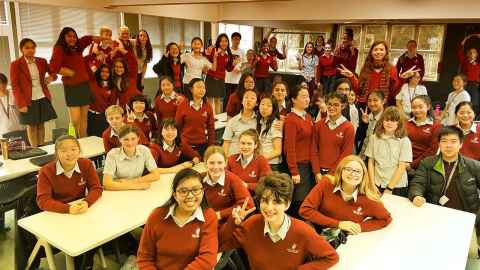Humanitarianism meets software engineering in new outreach project
23 October 2019
A collaboration between two Engineering student clubs led to a unique outreach programme for some Auckland high schools.

A group of fourteen students from our Software Engineering Students Association (SESA) and the Engineers without Borders (EWB) student chapter recently spent their mid-semester break volunteering at two Auckland schools as part of the latter's outreach programme.
Led by SESA's Sponsorship Manager and Part IV Software Engineering student Shurui Li, the volunteers visited 60 students from Westlake Girls High School and another 30 at St Paul's College for two hours each to demonstrate, teach, and work with a brand new programme that explores the basics of coding.
The new project was proposed by Shurui himself following his semester overseas as an exchange student at the University of British Columbia last year. It was then he started volunteering with their EWB branch.
When I returned, I was thinking about how I can maybe do something about software engineering as a member of SESA. The other reason is knowing that when I was in high school, I definitely never thought about any career stuff, and I just didn't know what was available out there. I thought, 'maybe I could sort of show the kids what we can do, and to start thinking about these things at that age'. I believe it's quite important not to have everything figured out, but just to start thinking about it.
EWB has had a pre-existing network of schools that hosts their volunteers for outreach activities for years, though this is notably the first time the student club has presented a software engineering module. It was made more unique with it being directly led by Shurui. He worked closely with EWB in Schools Team Lead Laureen Saveedra, who looked through the club's previous modules and concluded that they weren't fit for purpose. His solution was to start from scratch, which involved spending a lot of his own time outside of classes to develop new ones. The result can be seen as "software engineering, with a humanitarian spin."
Shurui's programme involved helping high school students to think about software engineering through two mini-exercises. The first is an icebreaker activity, where he coded his own variation of the game 2048 for students to complete. The second activity, which was more aligned to EWB, was a mobile application aimed at tackling the problem of wastage through understanding the circular economy: students "have to take a photo, and it'll tell you it's an apple. And that it's recyclable. They will need to upload their images to a website, label it correctly, and train the algorithm."
While the modules were aimed at students with no prior coding experience, Shurui suggests that everything they're doing "is real code", and set at a reasonable difficulty for their level.
It's not designed to be a very thorough introduction, but they do get to experience what coding is like for those specific purposes. I think the other point of this was to learn to not be afraid to try things, because it's pretty scary to see these university students come in... so I really wanted to show them how it's not actually that hard to do any of this. I know something like 'Machine Learning' is a big word, but that's why I brought it into both activities — Machine Learning that makes the app work, and the Machine Learning that plays the game against you.
Laureen, who is also a Part IV Civil Engineering student adds, "we generally bring our two modules to schools: Clean Water and Construction for Life. These are Civil Engineering-based modules, and over time we've realised haven't shown the whole range of what you can do in engineering so we have been looking at doing more software or mechanical-oriented stuff, so when this came up, it was a good opportunity."
To put together something new certainly comes with its challenges. Shurui not only designed the app and its website, but also trained the volunteers, some of whom haven’t been coding on a regular basis since their first year of studying Engineering. Bringing in software engineering also demanded resources in a different way. "With civil engineering activities, we do have to bring plenty of materials but they tend to be low-cost materials. This module involved using volunteers and their own laptops and phones", Laureen confirms.
There is also the complexity for volunteers to coordinate 60 young students at the same time. "We assigned between six to eight students for each volunteer. They were really helpful, and the students are actually pretty good. I think quite a few of them finished the exercise faster than we expected”, Shurui says.
Whether or not EWB volunteers will continue using Shurui’s modules are dependent on the network’s future cohort, though he has made all his work accessible to the public. Both him and Laureen agree that they’ve managed to achieve something quite significant, and enjoyed the challenge of trying something new, especially now that they’re about to graduate. While Laureen has been volunteering with EWB since her second year, Shurui’s reflection on his journey so far was slightly different.
I think it’s hard to say why I first did it. I was in Canada and I thought, I’m all the way in here so I should just go out there and do something. You know when people say that they always want to do something but don’t get to it? That was when I thought, ‘I’m on exchange now, so I should really make the most of it’.